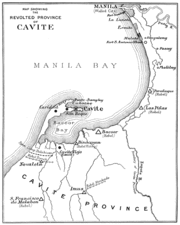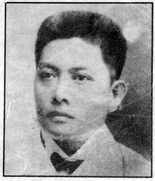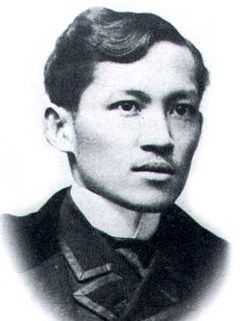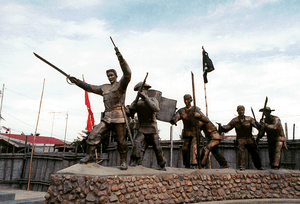Battle of Binakayan-Dalahican
| ||||||||||||||||||||||||||||||||
| ||||||||||||||||||||||||||||||||
The Battle of Binakayan-Dalahican[note 3] was a simultaneous battle during the Philippine Revolution that was fought from November 9–11, 1896 that led to a decisive Filipino victory. The twin battle took place at the shores of Binakayan, in the town of Cavite Viejo (also called Cavite el Viejo, now Kawit); Dalahican and Dagatan in Noveleta; and, to minimal extent, in Imus and Bacoor towns in Cavite province, Philippines that lasted for two days before the Spanish army retreated demoralized and in disarray. The result of the battle was the first significant Filipino victory in the country's history.
Background
By the time the Philippine Revolution began in August 1896, Cavite was one of the first provinces in the Philippines to declare independence from Spain. However, the El Supremo Andres Bonifacio, the leader and the instigator of the revolution, have been repeatedly defeated in battle, losing the morale of some men who are willing to join at his side, especially those who are from Bulacan and Morong provinces. In contrast, the revolutionaries in the province have been largely successful in battles since the start of the revolution against the Spaniards, who are often heavily outnumbered and its commanders, like in the case of the Spanish general Ernesto de Aguirre who was killed more than two months earlier during the Battle of Imus in September 1896, being overconfident and incompetent, and often outsmarted by their opponents, particularly the generals Emilio Aguinaldo of the Magdalo faction and Santiago Alvarez of the Magdiwang faction. The former successfully led a small uprising in Cavite el Viejo on August 31, 1896, where he defeated and killed the Spanish commander of the Guardia Civil, after Bonifacio's defeat at the Battle of San Juan del Monte. The leadership was then passed from his cousin, Baldomero, to him, where most of Magdalo members and revolutionaries regarded him as their leader.[7]
In Cavite, the Sangguniang Bayan (provincial council) of the Katipunan have two popular councils presiding its members over their respective areas. One of this council is the Magdiwang Council, which was headed by Mariano Álvarez encompassing the municipalities of Alfonso, Bailen (now called General Emilio Aguinaldo), Indang, Magallanes, Maragondon, Naic, Rosario, San Francisco de Malabon (now General Trias, Cavite), San Roque (now part of Cavite City), Tanza, and Ternate. The other council, Magdalo, is headed by Baldomero Aguinaldo and presides the towns of Amadeo, Bacoor, Carmona, Perez-Dasmariñas (now Dasmariñas), Cavite el Viejo, Mendez Núñez (now Mendez), and Silang.[8] Magdalo's name originated from Aguinaldo's nom-de-plume for Katipunan which was rooted from Santa Magdalena (Saint Mary Magdalene), Cavite Viejos's patron saint.[7] Magdalo held its capital in Imus, while Magdiwang was in Noveleta.[8]
Prelude

General Alvarez and Colonel Inocencio Salud took charge of the construction of the bamboo fortifications in Dalahican known as “Battery Numbers 1,2 and 3” in September 1896. Dalahican was a strategic barrio guarding the entrance to the Cavite peninsula.
Alarmed by previous siege done by General Aguinaldo in Imus, Cavite in September 1896, Governor-General Ramón Blanco y Erenas ordered the 4th Battalion of Cazadores from Spain to aid him in annihilating revolution in the province. On November 3, 1896, the battalion arrived carrying a squadron of 1,328 men and some 55 generals.[9] Apart from that, Blanco ordered some 8,000 men who recently came from Cuba and Spain when he learned that insurgents already occupied most of Las Piñas and Parañaque towns in the outskirts of Manila.[10]
Previous to the land attacks, Spanish naval raids were conducted on the shores of Cavite, where cannonballs were bombarded against the revolutionary fortifications in Bacoor, Noveleta, Binakayan and Cavite Viejo. The most fortified locations in Noveleta are the Dalahican and Dagatan shores defended by Magdiwang soldiers, while the adjacent fishing village of Binakayan in Kawit was fortified by Magdalo. Spanish naval operations were determined to crush the fortifications in these areas, mainly because the lake around Dalahican was so strategic as it connects to the interior of Cavite. Apart from defending Binakayan, the Magdalo soldiers also kept the lower part of Dagatan up to Cavite's border near Morong province (now Rizal province).[11]
The battle
.jpg)

The Katipunan revolutionaries, numbering 112,000 men including 35,000 ill-equipped hastily conscripted regulars and more than 60,000 militia (mostly irregulars or bolomen) desperately gathered from all Katipunan-controlled parts of Cavite, Laguna, Tayabas and Batangas provinces, entrenched a mile and a half long stockade and dense trench networks stretching between Noveleta along Dalahican and to the Morong-Cavite provincial border in the north, cutting of and preventing land reinforcements towards Cavite City. The city, the capital of the province, is connected by a narrow isthmus in Dalahican to the mainland Cavite. Blanco feared of the port city falling to the hands of the rebels. Each day, the stockade advances towards the isthmus. To prevent further mishaps and the fall of whole Cavite, Blanco launched twin attacks to the stockades in both Cavite el Viejo and Noveleta.
On November 8, Blanco commissioned Colonel José Marina to command the attack on Binakayan front in Cavite Viejo. The column assigned to Marina includes about 12,000-15,000 men, including more than 5,000 Spaniards: 1,600 marine infantry, two companies from 73rd Native Regiment, a company of artillery, 60 military engineers from the 6th Company of Engineers, two naval warships, and four gunboats. The 73rd Native Regiment includes Filipino native auxiliaries,[3] but more than 10,000 native mercenaries, loyalists and volunteers were also assigned to the attack on Binakayan.[3] Forts in Cavite City were opened to fire on approaching revolutionaries, while warships Castilla, Reina Cristina, and gunboats Bulusan, Leyte, Villalobos and Cebu destroyed stockades in Noveleta and Cavite el Viejo.[12]
The first attack on November 8 coincides with Cavite City's week-long fiesta celebrating its patron saint, Our Lady of Solitude of Porta Vaga. Despite the wails of revolution, pilgrims of the Virgin flocked the city, whereby revolutionists cooperated and attended all of the festivities and celebrations. The sound of cannonball hitting the shores of Cavite was only taken by local townsfolk as the enemy's contribution to the fiesta. By nightfall, Spanish firings intensified, but the rebels took no action to honor the Virgin of Solitude.[13]
Attack in Binakayan
At 6 a.m. on November 9, 1896 after a series of bombardment, Spanish soldiers launched a siege towards rebel fortifications in Binakayan and Dalahikan.[14]:82 The columns were twofold, the first one, commanded by Col. José Marina headed to Binakayan, while the second one, by General Diego de los Ríos approached entrenchments at Dalahican.
Meanwhile, Emilio Aguinaldo, the leader of the council defending Binakayan, headed to the boundary of Laguna and Batangas, thinking that the enemies would approach there. When he heard the news that Spanish forces are building up in Binakayan, he hurried back to defend the village. He was surprised to see that the Spanish forces could not enter the excellent trench designed by General Edilberto Evangelista, although, during the Spanish advance, Candido Tirona, one of the Katipunero generals, was stabbed in the neck and killed by a Spaniard while witnessing the battle and resting from a coconut tree not far from the shore. The Filipinos then conducted a series of massive counterattacks with their bolos and machetes to curb the Spanish advance heading towards Binakayan and Kawit.
On November 10, an old woman named "Gloria" (Gregoria P. Montoya) joined Aguinaldo while defending the fort. Because of age, Aguinaldo requested Gloria to leave the fortification, but she refused to. She said that she wanted to revenge the death of his Katipunero husband who died a day ago during the attacks in Dalahican.[14]:83 To serve the post, Aguinaldo gave Gloria several units to delay the incoming Spanish reinforcement marching from Bacoor, Cavite.[15]
One of the most significant and memorable contribution of Gloria to this battle was when she, herself only, dismantled the wooden bridge across Imus River in Mabolo, Bacoor, which connects the town of Bacoor to Cavite Viejo. Because of that, Spanish reinforcement were delayed in coming to Binakayan, though at the cost of her own life.[15]
On November 11, the Spanish forces advanced to destroy enemy entrenchment with no development of opposition from the rebels. When the army reached the road forking towards Cavite Viejo and Imus, the location became overwhelmed with a rain of projectiles in a long, dense line of entrenchments at short range. The main body for defending the fortifications were 22 Remington rifles, a German Mauser rifle and some native muskets and cannons gunned with improvised missiles made of scraped irons, which were destructive to about "500 arms length".[16] At each advancement, more Spanish soldiers were killed, including the officers. When the Spaniards saw that their lieutenants and generals were killed by the defense of Binakayan, they were demoralized with many retreating back to their ships while some of them headed back to Manila, thus, terminating the attack in Binakayan.[12] A small group led by Col. Marina (who had been wounded three times) rallied towards the entrenchment in Dalahican. The demoralized Spanish troops left about 200 guns, generally Mausers and Remingtons, and thousands of loads of cartridge and supplies in Binakayan.[3]
Attack in Dalahican
The Battle of Dalahican lasted for 36 hours as was in Binakayan. About 3,000 Spanish troops, under Blanco's orders, were marching towards Dalahican. Although initially successful in breaching Filipino defenses, the Spanish failed to totally destroy the former's positions and were thus under constant musket fire, melee charges and archer shoots by the Filipinos. During the battle, the dead bodies of the enemies and revolutionaries that perished were contained into three wells that were dug through Alvarez's command. The attack on Filipino positions by the Spaniards at Dalahican completely failed, suffering more than 1,000 casualties in the process, and by nightfall on November 11, the battle was over. They tried to retreat back towards Manila at the end of the battle, but, now cut off from Manila due to Filipino victory at Binakayan, fell back instead to Cavite City. Alvarez, along with their troops including those commanded by Aguinaldo who quickly joined the fray after Binakayan, then pursued the retreating Spanish and besieged Cavite City, where many Spanish soldiers surrendered to Aguinaldo.
Aftermath

The decisive victories at Binakayan and Dalahican saved most of Cavite province from being recaptured by the Spaniards (most of Cavite will be recaptured by the Spaniards upon Aguinaldo's exile by the provisions of the Pact of Biak-na-Bato in 1897). It paved the way for the Filipino revolutionaries to liberate nearby provinces from Spanish control. The Spanish colonial government became cautious of Aguinaldo's presence in Cavite, as this meant as long as Aguinaldo and his revolutionaries are in Cavite the revolution continues in the revolutionaries' favor; in fact, they are beginning to fear him more than they could on Bonifacio. To make matters worse, many more Filipinos in Batangas, Laguna, Pampanga, Bulacan and Morong joined the Katipunan independence movement inspired by the victory in Binakayan and Dalahican. The outcome of the battle even persuaded Bonifacio and his staff to retreat along with his men to the province to celebrate the victory with Aguinaldo and Alvarez. In the period following the twin battle, several townsfolk from all over nearby provinces raced to settle in the territory of the newly liberated Cavite, bringing with them their town bands, their patron saints and so on. This period of temporary peace saw what the settlers of Cavite called "Ang Panahon ng Tagalog" (the Tagalog Era). After the battle, the Spanish government sent a document issuing ceasefire to Aguinaldo and not Bonifacio, which act later angered the latter. The Spanish forces also have to recover for more than a month from this crushing defeat.
The battle made Aguinaldo, himself one of the chief commanders of the battle, a permanent legend and icon in Filipino history, as it was the first major Filipino victory of the war and of the Philippine history over a colonial power. Fighting the battle more decisively than Alvarez did on Dalahikan, who also recognized his ability to win the battle and convinced that he must be the leader of the revolution along with several others, Aguinaldo used his victory as pretext to consolidate his position on the Katipunan over Bonifacio, who himself suffered numerous defeats, during the Tejeros Convention the next year, where he won as the first president of the Philippines.[17] However, it also paved the way for the execution of the Filipino doctor and nationalist, José Rizal, more than a month later after the battle, due to charges of rebellion, sedition, and conspiracy by the Spanish government. Ramon Blanco, the Spanish governor-general of the Philippine islands at the time, gave Rizal lead to leave the islands for Cuba, but was thus arrested while en route. The execution occurred in December 30 the same year, effectively ending the ceasefire Blanco and Aguinaldo had signed after the battle.
Notes
References
- ↑ Heston 1977, p. 204
- ↑ Foreman 1906, p. 378
- ↑ 3.0 3.1 3.2 3.3 3.4 "Army: Historical background". Retrieved 28 October 2010.
- ↑ Davis 1903, pp. 193–194
- ↑ 5.0 5.1 Foreman 1906, p. 374
- ↑ Davis 1903, p. 195
- ↑ 7.0 7.1 Zaide 1957, p. 165
- ↑ 8.0 8.1 Halili 2004, p. 147
- ↑ Davis 1903, p. 192
- ↑ Foreman 1906, p. 373
- ↑ Alvarez 1992, p. 49
- ↑ 12.0 12.1 Davis 1903, p. 194
- ↑ Alvarez 1992, pp. 62–63
- ↑ 14.0 14.1 Alvarez, S.V., 1992, Recalling the Revolution, Madison: Center for Southeast Asia Studies, University of Wisconsin-Madison, ISBN 1-881261-05-0
- ↑ 15.0 15.1 "Gregoria P. Montoya". National Historical Commission of the Philippines. Retrieved on 2013-07-10.
- ↑ Alvarez 1992, p. 63
- ↑ Guevara, Sulpicio, ed. (1972) [1898]. The laws of the first Philippine Republic (the laws of Malolos) 1898–1899. English translation by Sulpicio Guevara. Manila: National Historical Commission. ISBN 9715380557. OCLC 715140.
External links
| Wikimedia Commons has media related to Battle of Binakayan-Dalahican. |
Bibliography
- Alvarez, Santiago V. (1992), The Katipunan and the Revolution: Memoirs of a General, Paula Carolina S. Malay (translator), Ateneo de Manila University Press, ISBN 971-550-077-3 ISBN 978-971-550-077-7
- Davis, George W. (1903), Annual report of Major General George W. Davis, United States Army commanding Division of the Philippines from October 1, 1902 to July 26, 1903 (PDF), Manila, P.I.. Archived on Internet Archive
- Foreman, John (1906), The Philippine Islands: A Political, Geographical, Ethnographical, Social and Commercial History of the Philippine Archipelago, Embracing the Whole Period of Spanish Rule (Third ed.), New York: Kelly & Walsh, Ltd.
- Halili, M.C. (2004), Philippine History, Rex Bookstore, Inc., ISBN 971-23-3934-3 ISBN 978-971-23-3934-9
- Zaide, Gregorio F. (1957), Philippine Political and Cultural History: the Philippines Since the British Invasion II (1957 Revised ed.), Manila: McCullough Printing Company
